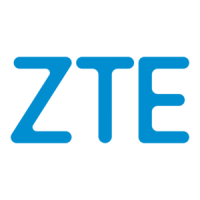Chapter 5 - Software Structure
Confidential and Proprietary Information of ZTE CORPORATION 47
Telnet provides the access interface, and functions are implemented in
foreground modules.
Database System
Overview
The database system provides data support for the whole system.
1. System Functions
The ZXMSG 5200 database system is composed of a database and a
database management software. The database is a structurized data
set, covering data themselves and relations between the data. The
database, independent of applications, is the core and management
object of the database system. The database software is responsible
for database management and maintenance and serves to define,
describe, operate and maintain the data. The software accepts and
fulfils different requests from application programs and databases and
it is also responsible for data security.
The database system aims to provide database access interfaces for
the ZXMSG 5200 system software. The database management system
specially provides various dedicated access interfaces.
2. System performance
The database system can satisfy other modules requirements on data
in the system, and provides data loading when the system restarts,
proper and convenient data configuration and global data consistency
in the system.
Data Structure
The ZXMSG 5200 builds the data system on the foreground. The Telnet
mode provides data configuration. The data maintenance and
configuration are separated form the system operation, that makes the
system more reliable.
The data system is composed of the following modules: data interface
module, resource management module and data active/standby
synchronization module, database maintenance management module and
man-machine command module.
Functions of each module are as follows:
1. Data Interface Module
The database system provides data support for subsystems via data
interfaces which includes call data interface (CALL module), system
data interface (R system), performance statistics interface and
configuration data interface (H.248 protocol system and support
system). The data interface module can visit the database directly for
handling simple data; but other modules must take part in handling
more complicate data requirements like get access to resources or data
area.

